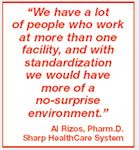Standardizing IV practices can reduce patient harm
With what may turn out to be a nationwide model, hospitals in San Diego have joined forces in an effort to reduce the number of adverse drug events (ADEs) associated with intravenous medication administration.

San Diego County hospitals, along with the San Diego Patient Safety Consortium and the Cardinal Health Center for Safety and Clinical Excellence, created a regional task force designed to improve patient safety by eliminating variations in high-risk IV medication practices among local hospitals. The task force is targeting IV practices because, according to a recent IOM report, 61% of the most serious and life-threatening potential ADEs are related to IV medications.
Among the countywide standards established for safe administration of IV medications are using a common drug identifier and standardizing the concentration and dosage units for individual drugs. "We wanted to create a standard way that the drugs are mixed, and our hope is to reduce the incidents of errors made with IV infusions," said Nancy Pratt, R.N./MSN, senior VP of clinical effectiveness at Sharp HealthCare System and a member of the task force.

According to experts, incorrect dosing due to confusion among medications and the complexity of the medication-use process are an ongoing problem related to drug administration. By standardizing high-risk IV drug concentrations and dosage units across all of San Diego's hospitals, pharmacists, physicians, and nurses expect to see reduced complexity and improved compliance. Included among the high-risk drug categories associated with IV infusion are insulin, anticoagulants, and narcotics.
According to Joseph Scherger, M.D., professor, Department of Family and Preventive Medicine, University of California, San Diego School of Medicine, the classes of IV drugs most likely to cause adverse drug events are insulin and heparin. Narcotics, anesthetics, and other drugs with a narrow therapeutic window are a close second. "Any deviation by a missed decimal point or an extra zero can result in catastrophe," he said.
Supporters of standardization point out that when infusion practices differ from one patient care area to another, from one hospital to another, or when per diem nurses and recent graduates are utilized, increases in errors are more likely.
For instance, there are differences between hospitals in the way insulin is mixed. Some hospitals mix one unit per ml, whereas another facility might mix one unit in 4 ml. "That's a completely different concentration, and that just creates a risky situation," said Pratt. Another example is when one hospital uses an infusion rate of milligrams per minute and another uses milligrams per hour, selecting the wrong dosage unit could result in an overdose. "If you have per diem or floater nurses, it behooves you to eliminate opportunities for error and confusion," said Rizos.
Although the task force was made up of pharmacists, nurses, and physicians, pharmacists in particular played a vital role, noted Rizos. "Pharmacists know the pharmacotherapy of the drug. There are times when you have two indications for a drug and you need to be careful with concentrations you choose to make sure they still work and that the product is stable."
In the end, noted Scherger, it's all about preventing errors and saving lives. "Health care is way behind aviation and other serious life-and-death industries in standardizing things to reduce errors," he concluded.